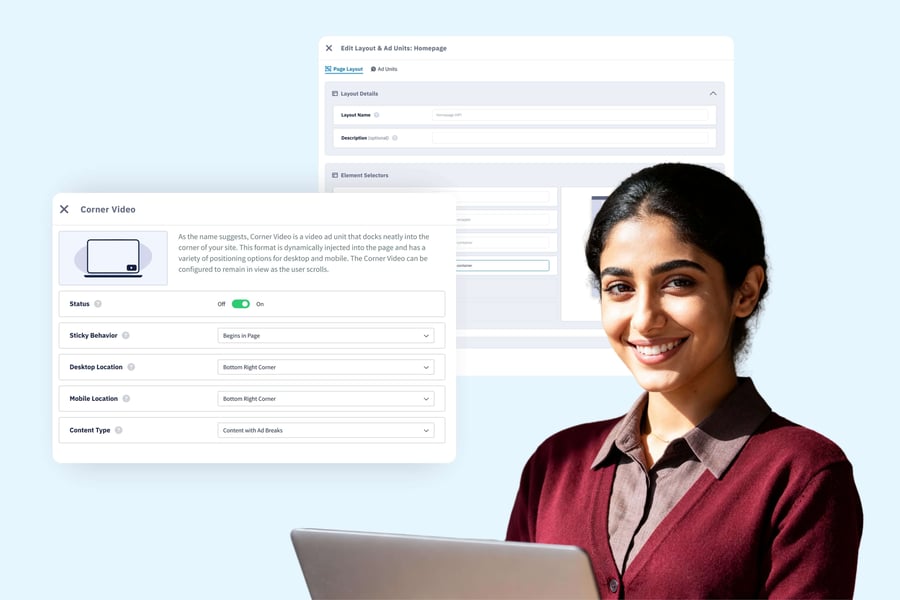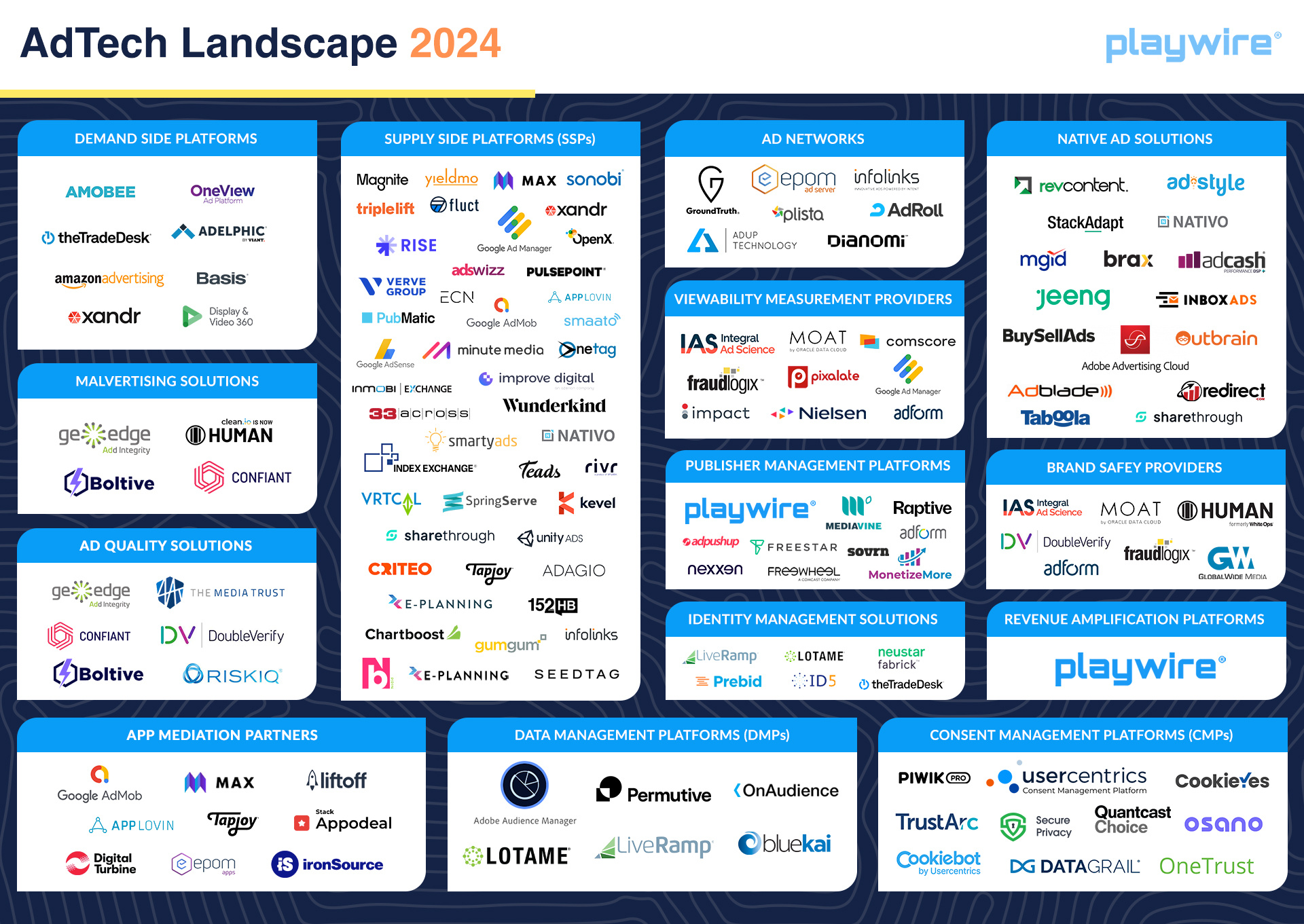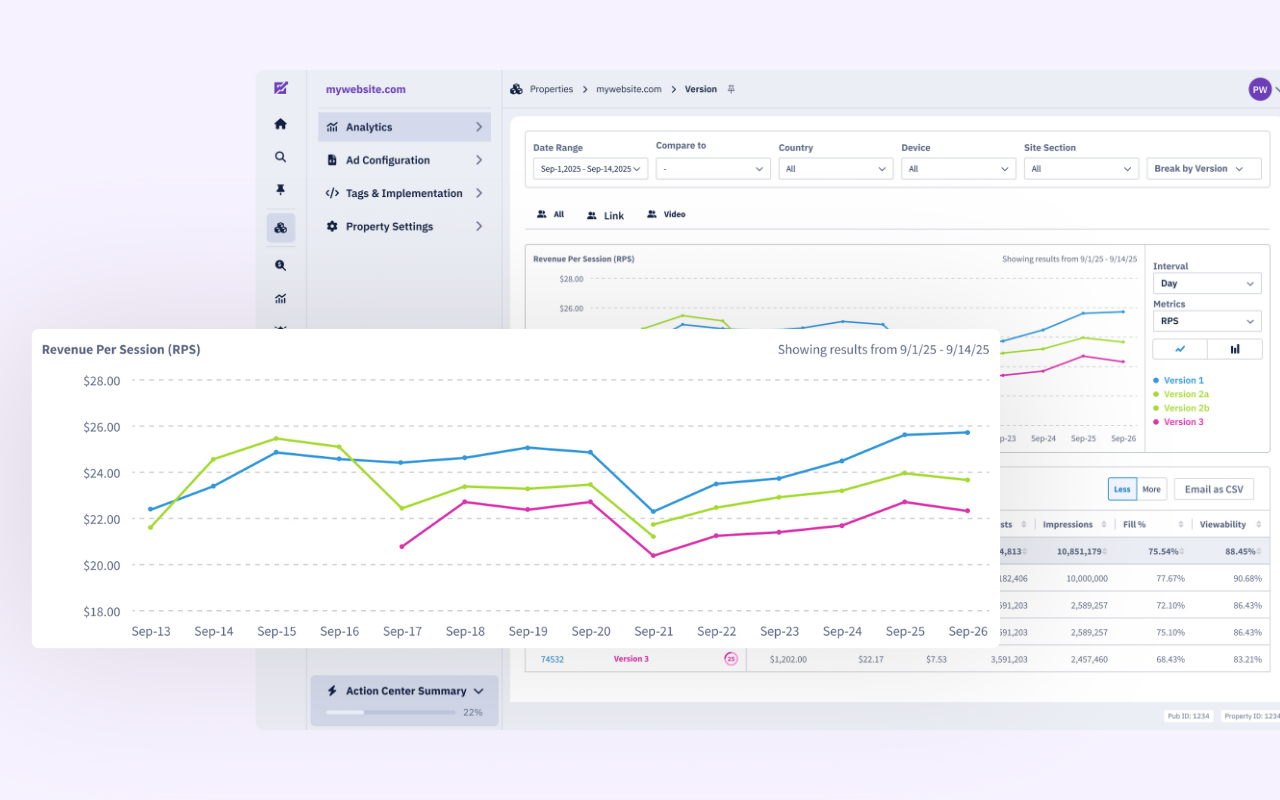Ad Tech for Publishers: Essential Tools and Platforms to Maximize Revenue
October 28, 2025
Editorial Policy
All of our content is generated by subject matter experts with years of ad tech experience and structured by writers and educators for ease of use and digestibility. Learn more about our rigorous interview, content production and review process here.

Key Points
- Ad servers form the foundation: Modern ad servers coordinate all aspects of ad delivery, from inventory management to campaign tracking, making them the central hub of your monetization infrastructure.
- Header bidding technology multiplies demand: Implementing header bidding lets multiple demand sources compete simultaneously for your inventory, driving CPMs higher than traditional waterfalls.
- Analytics tools reveal revenue opportunities: Real-time reporting and granular data analysis identify which content, placements, and audiences generate the most value.
- Identity solutions preserve targeting: First-party data strategies and identity resolution platforms maintain addressability as third-party cookies disappear.
- Stack complexity has real costs: Managing individual point solutions requires significant technical resources, making integrated platforms increasingly attractive for many publishers.
Understanding Ad Tech for Publishers: The Direct Answer
Ad tech for publishers encompasses the technology platforms that enable buying, selling, and delivering digital advertising on your properties while maximizing revenue. The essential components include:
- Ad servers for inventory management
- Header bidding wrappers for demand competition
- Analytics platforms for performance tracking
- Identity solutions for audience targeting
- Data management systems for audience intelligence
Publishers who strategically deploy these tools typically see 20-50% revenue increases compared to basic ad serving alone, though actual results depend on current setup and optimization expertise.
The average publisher's ad tech stack includes between 5 and 15 different platforms. Each one promises to optimize a specific function. Each one requires integration, maintenance, and ongoing management.
The question isn't whether you need ad tech for publishers. The question is which tools actually move the needle on revenue, and how you can deploy them without building an entire engineering team.

The Ad Tech Stack Reality Check
Publishers today face a paradox. You need sophisticated technology to maximize revenue, but managing that technology can consume resources faster than it generates returns.
Think of your ad tech stack as the engine that converts your traffic into revenue. A well-tuned engine delivers maximum power efficiently. A poorly configured one burns resources while underperforming.
The ecosystem evolved from simple direct sales systems into a complex programmatic marketplace. Publishers who understand each component can make strategic decisions about their stack. Publishers who don't often leave money on the table.
Visit our Ad Tech Stack Resource Center.
Essential Components of Ad Tech for Publishers
Modern ad monetization requires several interconnected systems working together. Each component handles specific functions in the revenue generation process.
Your stack needs tools that manage inventory, facilitate auctions, deliver ads, measure performance, and maintain compliance. Some publishers build these capabilities piece by piece. Others opt for integrated platforms that combine multiple functions.
The right approach depends on your scale, technical resources, and business priorities. Let's examine each essential component.
Ad Servers: Your Revenue Command Center
Ad servers function as the central nervous system of your ad operations. They make real-time decisions about which ads to show, track delivery and performance, and ensure compliance with business rules.
Modern ad servers handle inventory management across all your properties. They organize ad units, set targeting parameters, and control which demand sources can access specific placements. This centralized control prevents conflicts and maintains quality standards.
The server receives ad requests from your pages, evaluates available demand sources, and selects the winning ad based on your priorities. This happens in milliseconds. The ad server then delivers the creative, tracks the impression, and logs detailed reporting data.
Core Function | What It Does | Impact on Revenue |
Inventory Management | Organizes ad units and controls access across properties | Prevents inventory conflicts and maintains quality standards |
Auction Mediation | Coordinates between demand sources and selects winning bids | Ensures highest-paying ads win each impression |
Creative Delivery | Serves ad content and tracks display metrics | Optimizes load times and viewability rates |
Reporting & Analytics | Logs performance data and generates insights | Identifies optimization opportunities and tracks revenue trends |
Compliance Controls | Enforces business rules and ad quality standards | Protects user experience and advertiser relationships |
Google Ad Manager dominates the ad server market for publishers with substantial scale. It offers robust functionality but requires significant expertise to optimize. The platform's complexity means many publishers never fully leverage its capabilities for programmatic advertising success.
Alternative ad servers exist, but most integrate with Google's ecosystem regardless. The real question isn't which ad server to use for your publisher ad tech stack. The question is whether you have the resources to configure and optimize it properly.
Header Bidding: Amplifying Competition for Your Inventory
Header bidding revolutionized publisher monetization by introducing true auction dynamics. Multiple demand sources bid simultaneously on each impression, with the highest bid winning access to your inventory.
Traditional waterfalls limited competition. Demand sources received inventory sequentially based on priority settings. Header bidding changed this by letting everyone compete at once.
The technology executes in the browser before your ad server is called. Bidders submit their offers, the header bidding wrapper collects responses, and the highest bid passes to your ad server. This parallel auction structure consistently delivers higher CPMs than waterfall setups.
Key Header Bidding Benefits:
- Increased competition: Multiple demand sources bidding simultaneously drives prices higher than sequential waterfalls
- Improved fill rates: More bidders means fewer unfilled impressions and reduced revenue gaps
- Better price discovery: Real-time competition reveals the true market value of each impression
- Reduced latency: Modern wrappers optimize timeout settings and asynchronous loading to maintain page speed
- Granular controls: Configure bidder participation, timeouts, and price floors at the placement level
Header bidding wrappers like Prebid provide the framework for this auction. Publishers can build their own wrapper implementations or use managed solutions. Building in-house requires significant JavaScript expertise and ongoing maintenance. Managed solutions handle the technical complexity but may limit customization options.
The wrapper orchestrates the entire process. It calls bidders, manages timeouts, and passes winning bids to your ad server. A well-configured wrapper balances competition against latency, maximizing revenue without degrading user experience.
Read our Header Bidding Guide.
Analytics and Reporting: Seeing What Actually Drives Revenue
You can't optimize what you can't measure. Analytics tools transform raw ad serving data into actionable insights about your monetization performance.
Basic reporting shows you aggregate metrics: revenue, impressions, CPMs, fill rates. Advanced analytics break down these metrics by content type, audience segment, device category, geographic region, and dozens of other dimensions.
The real power comes from granular analysis. Which articles drive the highest session RPMs? Which traffic sources deliver the most valuable audiences? Which ad units underperform and drag down your overall yield?
Essential Analytics Capabilities:
- Real-time dashboards: Monitor current performance and catch issues before they impact revenue significantly
- Granular breakdowns: Analyze metrics by URL, device, geography, referrer, audience segment, and custom dimensions
- Revenue attribution: Understand which content and traffic sources generate the most monetization value
- Comparative analysis: Track performance trends over time and benchmark against historical baselines
- Custom reporting: Build specific views for different stakeholders and business questions
Bridging this gap requires custom integration. You need to connect traffic data with revenue data to understand the complete picture. Some platforms handle this automatically. Others require manual data exports and spreadsheet analysis.

Identity Solutions: Maintaining Addressability
Third-party cookies are disappearing. Publishers need alternative identity strategies to maintain addressable inventory and support audience targeting.
Identity solutions create persistent user identifiers without relying on third-party cookies. These identifiers let you segment audiences, frequency cap effectively, and support advertiser targeting needs.
First-party data forms the foundation. When users register, subscribe, or authenticate, you gain deterministic identity signals. Authenticated traffic commands premium CPMs because advertisers can target and measure more effectively.
Identity Strategy Components:
- First-party data collection: Registration systems and authentication flows that capture user information directly
- Identity resolution: Platforms that connect user signals across devices and sessions into unified profiles
- Universal IDs: Shared identifier frameworks that work across publishers and maintain consistency
- Contextual enrichment: Content analysis and page-level signals that inform targeting without user tracking
- Consent management: Systems that collect and respect user privacy preferences while maximizing addressability
Universal ID solutions like Unified ID 2.0 provide shared frameworks. Users authenticate once and their identifier follows them across participating properties. This maintains addressability while respecting privacy controls.
Contextual targeting makes a comeback as identity becomes harder. Advertisers target based on page content and context rather than user history. Quality content attracts premium advertisers regardless of identity limitations.
Publishers with strong first-party relationships navigate this transition more successfully. If you can authenticate even a portion of your audience, those sessions become significantly more valuable.
Data Management Platforms: Audience Intelligence
Data Management Platforms organize and activate your audience data. They collect signals from multiple sources, build user segments, and make those segments available for targeting.
DMPs integrate traffic data, CRM information, and third-party datasets into unified audience profiles. Publishers can create custom segments based on behavior, content consumption, demographics, or any available signal.
These segments drive revenue in two ways. First, they support more effective direct sales by letting you package audiences for advertisers. Second, they improve programmatic yield by sharing audience data with demand sources.
Premium DMPs offer sophisticated features. Lookalike modeling finds users similar to your best audiences. Predictive analytics identify users likely to take specific actions. Cross-device graphing connects user activity across platforms.
The challenge with DMPs involves data accuracy and ongoing maintenance. Segments degrade over time as user behavior changes. You need to regularly refresh and validate your audience definitions.
Visit our full Ad Monetization Platform resource center.
Building Your Stack vs. Integrated Solutions
Publishers face a fundamental choice when selecting ad tech for publishers. Build a custom stack from best-of-breed components, or use an integrated platform that combines multiple functions.
Custom stacks offer maximum flexibility. Choose exactly which tools to use for each function. Optimize each component independently. This approach works well for large publishers with dedicated ad ops teams — those considering enterprise ad monetization platforms for their scale.
The downsides are significant. Each integration requires engineering resources. Multiple vendor relationships need management. Debugging issues across platforms becomes complex. Optimization requires deep expertise in each tool.
Custom Stack Considerations:
- Technical resources required: Dedicated ad ops and engineering teams to manage integrations and optimizations
- Ongoing maintenance burden: Regular updates, troubleshooting, and performance monitoring across multiple platforms
- Integration complexity: APIs, data syncing, and compatibility issues between disparate systems
- Vendor relationship management: Separate contracts, support channels, and SLAs with each provider
- Performance optimization: Deep expertise needed in each platform to extract maximum value
Integrated platforms consolidate multiple functions into unified systems. One integration point, one relationship, one support channel. These solutions handle complexity behind the scenes while providing simplified management interfaces.
RAMP Self-Service exemplifies this approach for digital publishers. The platform combines header bidding, price floor optimization, ad serving coordination, identity solutions, and analytics in a single system. Publishers access granular controls when needed but can rely on AI-driven optimization for complex decisions.
The tradeoff involves customization limits. Integrated platforms make opinionated choices about configuration and functionality. You gain simplicity but potentially sacrifice some flexibility.
Scale matters in this decision. Smaller publishers rarely have resources to manage complex custom stacks effectively, making top ad monetization platforms critical for their success. Larger publishers may already have the teams and infrastructure in place.
Frequently Asked Questions About Ad Tech for Publishers
What is ad tech in publishing?
Ad tech in publishing refers to the software platforms and tools that enable publishers to sell, manage, and optimize digital advertising inventory. This includes ad servers for delivery, header bidding for demand competition, analytics for performance tracking, and identity solutions for audience targeting.
What are the core components of a publisher ad tech stack?
The essential components include an ad server (inventory management and delivery), header bidding wrapper (demand source competition), analytics platform (performance insights), identity solution (user targeting), and data management platform (audience segmentation). Publishers may add specialized tools based on their needs.
How much does ad tech cost for publishers?
Costs vary significantly based on stack complexity. Basic Google AdSense is free but limits revenue potential. Header bidding wrappers like Prebid are free but require technical resources. Premium ad servers and DMPs charge based on impressions or revenue share. Integrated platforms typically operate on revenue share models between 20-30%.
Should publishers build or buy their ad tech stack?
Publishers with over 50 million monthly pageviews and dedicated ad ops teams can consider custom stacks. Smaller publishers typically see better ROI with integrated platforms that provide enterprise capabilities without enterprise complexity. The decision depends on technical resources, scale, and strategic priorities.
What is header bidding and why do publishers need it?
Header bidding is a programmatic advertising technique that lets multiple ad exchanges bid on inventory simultaneously before the ad server is called. Publishers need it because parallel auctions consistently deliver 20-50% higher CPMs than traditional waterfall setups by creating real-time competition for every impression.
How do publishers measure ad tech performance?
Publishers track key metrics including page view CPM, session RPM, fill rate, viewability, and revenue by traffic source. Advanced analytics break down performance by content type, audience segment, device, and geography. Integrated dashboards connecting traffic and revenue data provide the most actionable insights.
Why Playwire Solves the Ad Tech Complexity Problem
Most publishers want revenue, not ad tech expertise. You're in the business of creating content, not managing bidder relationships and debugging wrapper configurations.
Playwire built RAMP Self-Service to give you both control and automation. Use our proven configurations out of the box. Customize exactly what matters to you. Let machine learning handle the thousands of optimization decisions that humans can't scale.
The platform combines all essential ad tech components into a single system. Header bidding, price floors, identity solutions, and analytics work together seamlessly. You get enterprise-grade capabilities without enterprise-level complexity — delivering revenue increases that justify the partnership.
View how RAMP Self-Service delivers true transparency and control for publishers ready to maximize their ad revenue without the operational burden of managing multiple vendor relationships.

-1.png?width=800&height=157&name=1-playwire-logo-primary-2021%20(1)-1.png)









